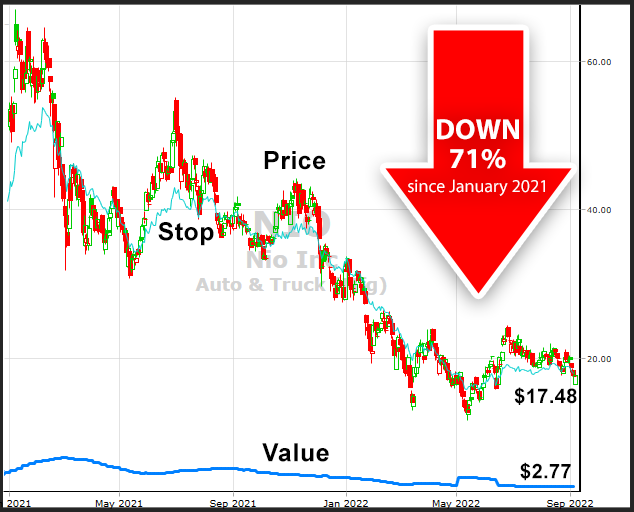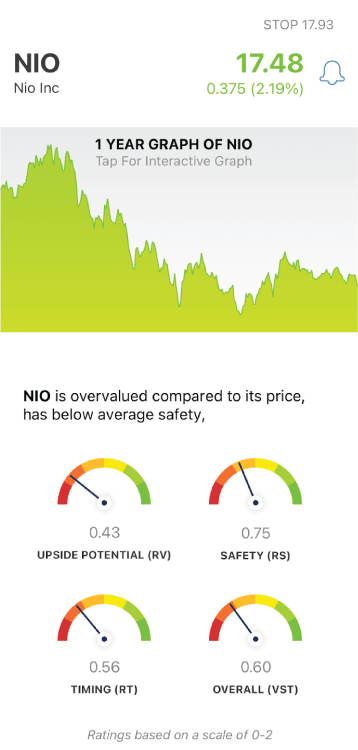It’s been an interesting few years for automakers – as supply and demand in this industry continue to twist and turn, keeping investors guessing along the way. However, things appear to be leveling off on the demand side – and the supply side is finally starting to catch up. As such, we’re seeing the auto market cool off a bit. Nevertheless, the demand for electric vehicles in particular continues to grow. As such, companies like Tesla are thriving. However, one EV manufacturer out of China has not been as fortunate. Today, we’re going to discuss Nio – and what their 2nd quarter earnings report means for investors.
At one point, things looked good for Nio. Founded in 2014, the company’s stock reached an all-time high of around $62 in January 2021. Since then, though, Nio’s stock price has gradually slid down to where it sits today – at just $17. Just this year alone, shares have fallen almost 60%. And the 2nd quarter earnings report reflects much of what we’ve witnessed over the past year and a half. Nio missed revenue guidance by a large margin with a wider-than-expected loss in the quarter. This comes despite a rise in deliveries of 14% year-over-year along with an 8.5% hike in revenue.
There are a few reasons Nio disappointed analysts and investors in the previous quarter. The first setback comes from another popular stock we’ve discussed here at VectorVest: Nvidia. This chipmaker has had new export curbs placed upon them, and this has drastically affected Nio’s ability to scale production. Moreover, EV competition has heated up dramatically in the past few years. It’s no longer just Tesla making waves – companies like Volkswagen have begun to outpace Nio as well. Moreover, Nio is a Chinese company and is subject to the fierce lockdowns this country currently has in place – further affecting production, while also inhibiting demand in their home country.
As a result of the abysmal second-quarter earnings report, Nio shares dropped 10% over the past week. This is something you could have seen coming in the VectorVest platform – as our trend indicators were already showing downward price movement. So, with all this being said – is now the time to sell Nio, or should investors weather the storm? Or, is this a good opportunity to buy low? After all, Nio has big plans to grow its EV lineup, expand abroad, and challenge the likes of Volkswagen. To answer this question, let’s break down the stock using the VectorVest stock analysis system.
3 Key Findings Our Stock Analysis System Shows for Nio
The VectorVest stock analysis system compiles all technical and fundamental analysis and boils it down to 3 simple ratings: Relative Value (RV), Relative Safety (RS), and Relative Timing (RT). These are placed on a scale of 0.00-2.00, with 1.00 being the average. The closer to 2, the better, and the closer to 0, the worse a stock is performing. Together, these three ratings make up the overall VST rating a stock is given – and dictate where it’s rated a buy, sell, or hold. So, what does the VectorVest system show for Nio? Unfortunately, there’s nothing positive to discuss here:
- Very Poor Upside Potential: Despite Nio’s plans to right the ship, the VectorVest system shows a very poor RV rating of 0.43. This suggests that the long-term price appreciation potential for Nio leaves much to be desired. Moreover, the stock is way overvalued at its current price of $17.49/share. Our system shows an intrinsic value closer to $2.77/share.
- Poor Safety: The relative timing indicates the risk a stock has at any given time – taking into account the consistency and predictability of a stock’s financial performance and business longevity, along with other factors. And as for Nio, it has poor safety with an RV rating of 0.56. This is coupled with a very poor comfort index (CI) of 0.40. This rating suggests an inability to withstand severe or lengthy price declines.
- Poor Timing: To top it all off, there is a negative price trend putting downward pressure on Nio’s stock price. The relative timing rating takes into account the direction, magnitude, and dynamics of a stock’s price movement. And right now, Nio’s RT rating is just 0.56. This suggests the trend we’re seeing right now will continue for the foreseeable future.
All this considered, the overall VST rating for Nio works out to 0.60 – which is poor. But does that mean the time to sell is now – or is there still hope for investors who currently have an open position in Nio? Get a free stock analysis today to discover the answer you need to know…
Want These Types of Insights at Your Fingertips so You Can Win More Trades?
Use VectorVest to Analyze any stock free. VectorVest is the only stock analysis tool and portfolio management system that analyzes, ranks and graphs over 18,000 stocks each day for value, safety, and timing and gives a clear buy, sell or hold rating on every stock, every day.
VectorVest advocates buying safe, undervalued stocks, rising in price. As for Nio, it has very poor upside potential, it’s risky, and has a negative trend pushing the stock’s price down even further right now.
Before you invest, check VectorVest! Click here to ANALYZE ANY STOCK FREE and see our system in action!













Leave A Comment